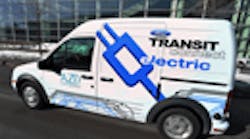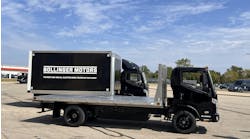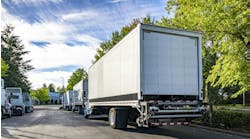Alternative power for trucks
Every new power option has its benefits and its limitations. Success depends upon choosing the right technology for your specific application.
HYBRIDS:
The value proposition for commercial hybrid vehicles is strongest for vehicles in stop and go operations and for vehicles that can use hydraulic or electric power to operate chassis-mounted equipment, such as the lifts on utility trucks. It is no accident, therefore, that transit, tour and school bus fleets; pick-up and delivery operations; utility companies; and refuse fleets have been among the first to deploy hybrids in significant numbers.
- E3 hybrid-powered refuse truck: Jointly developed with Parker Hannifin. Stores energy from braking to supplement the power of the diesel engine. Designed for high-start and -stop applications, the E3 incorporates RunWise technology by Parker Hannifin.
- Freightliner M2 Business Class 106 Hybrid : Features the same benefits as the Freightliner Business Class M2. The hybrid is designed to be configured for a wide variety of bodies for different applications, such as beverage, dump, government, landscape, towing, utility vehicles, and emergency.
All of DTNA’s hybrid products are equipped with EPA 2010-compliant engines utilizing selective catalytic reduction (SCR) technology and the Eaton Hybrid Electric Drivetrain System, a parallel hybrid system that enables the truck to operate using the diesel engine alone, or in combination with the hybrid electric motor. The hybrid-electric motor provides power to launch and accelerate the truck and the electric power comes from regenerative braking while the vehicle is slowing down. DTNA hybrid's can also be equipped with electronic PTO and/or 110V power generation capabilities to power hydraulics, lights, tools, or other equipment for job site or refrigerated cargo applications.
- E450 Cutaway and Stripped Chassis gasoline-electric “Balance Hybrid:” modified by Azure Dynamics. The Balance hybrid electric drive system manages the conventional 5.4 liter Triton gasoline engine and the 5-speed automatic TorqShift transmission. Features electric-launch assist, engine-off at idle and regenerative braking.
Freightliner Custom Chassis Corp.:
- MT55 Delivery Vehicle: with Eaton Hybrid System and Cummins 6.7L Engine
- MT45 Delivery Vehicle: with Eaton Hybrid System and Cummins 6.7L Engine
- GMC Yukon Hybrid and GMC Yukon Denali Hybrid: Equipped with GM's hybrid technology, GMC hybrids feature Vortec 6.0L V8 SFI engine LIVC with Active Fuel Management, Hybrid Propulsion Electric with 300-volt Energy Storage System.
- Chevrolet Silverado Hybrid 1500: Uses GM's 2-Mode Hybrid system and 6.0L gas V8 engine. Available as a Crew Cab Short Box in 2WD or 4WD versions. Limited availability.
- GMC Sierra Hybrid 1500: Uses GM's 2-Mode Hybrid system and 6.0L gas V8 engine. Available as a Crew Cab Short Box in 2WD or 4WD versions. Limited availability.
- DuraStar: with Eaton Hybrid System. 4x2 in day cab, extended cab or crew cab at 23,500 to 44,000 GVWR.
- T270 and T370 Diesel-Electric Hybrid: 25,000-pound GVWR Class 6 and 33,000-pound Class 7 hybrids powered by PACCAR PX-6 engine. The system automatically switches between the two modes of operation. Stored electricity provides nearly 60 horsepower with 310 footpounds of torque. Uses regenerative braking to generate and store electricity. Can also be spec’ed with an electric power-take-off, which allows energy to be drawn from the batteries for engine-off operation.
- Model 320 Hybrid Hydraulic Launch Assist (HLA): A parallel hybrid powertrain that captures a portion of the vehicle’s kinetic energy in the form of hydraulic pressure during braking, and releases that energy to supplement the vehicle’s engine for launch assistance. It is especially suited to refuse operations.
The core of the hydraulic hybrid is the Eaton Hydraulic Launch Assist System. The major components of the system include the pump/motor, high pressure accumulator, and low pressure reservoir. During acceleration, fluid in the high-pressure accumulator is metered out to drive the pump/motor as a motor, propelling the vehicle by transmitting up to 380 horsepower and 2,550 ft-lbs of torque.
- Model 330 Hybrid Electric (HE): Designed to meet the needs of a wide variety of medium-duty applications, especially lease, rental and pick-up and delivery applications. The Model 330 HE is available with a 26,000 pound GVW rating, and can also be configured for non-CDL operation with hydraulic brakes for a greater range of driver options. The integration of the Eaton Hybrid Drive System and the PACCAR PX-6 engine delivers up to 860 ft-lbs of torque.
- Model 337 Hybrid Electric (HE): Available in a Class 7 configuration, the 337 is designed to work in a wide array of applications, including inter- and inner-city pick- up and delivery, fire and rescue, beverage, municipal and refuse.
- Model 348 Medium-duty Hybrid: Spec’d as a Class 7 truck with a 39,000 pound GVWR rating, the 348 is suited for municipal, service and utility applications. When configured for a utility application, significant fuel savings can be realized during both on-road and stationary use through the electric operation of the Power –Take-Off (PTO) that utilizes onboard lithium-ion batteries, which allow the body to operate with the engine off, notes Peterbilt. Once this power is depleted, an automatic engine start and shut down sequence occurs to recharge the batteries.
Continue to read about Natural Gas, Propane and all-electric options
NATURAL GAS:
Fleets most apt to be successful in deploying natural gas vehicles have the ability to fuel centrally or have other easy access to fueling stations, good OEM support, good maintenance practices and well-trained technicians, and a commitment to proper and regular cylinder inspections.
When it comes to choosing between liquefied natural gas (LNG) or compressed natural gas (CNG), LNG tends to be used in the Class 7-8 range, while CNG is more popular in Class 4-6 vehicles.
- Freightliner Business Class M2 112: Natural gas tractors
- Transit Connect: CNG engine prep packages offered on Transit Connect, including the new taxi offering, the E-Series, the 2011 Super Duty F-450 and F-550 Chassis Cab.
Ford provides calibration guidance to CNG upfitters for E-Series, F-Series and Transit Connect. By following Ford's recommendations published in the Body Builders Advisory Service QVM Bulletin Q-185, the converted vehicle maintains factory engine warranty.
- E-Series CNG Cargo Vans: 5.4 L/2V (see above)
- E-Series CNG Cutaway and Stripped Chassis: 5.4L/2V and 6.8L/2V (see above)
- F Series CNG Super-Duty Pick-up: 6.2L/V-8 (see above)
- F Series CNG Super Duty Chassis Cabs: 6.8L/3V (see above)
- F53 and F59 Stripped Chassis: 6.8L/3V
- Chevrolet Express 2500 and 3500 CNG Cargo Vans: Uses a 6.0L Vortec V8 engine with factory-installed hardened exhaust valves and intake/exhaust valve seats. Two systems are offered: (UFM) 3-tank system provides a range up to 200 miles. Allows for use of complete cargo area. (UFP) 4-tank system provides a range up to 300 miles. This system adds a single tank in the driver's side of the cargo area, just inboard of the wheel well.
- GMC Savana 2500 and 3500 CNG Cargo Vans: Uses a 6.0L Vortec V8 engine with factory-installed hardened exhaust valves and intake/exhaust valve seats. Two systems are offered: (UFM) 3-tank system provides a range up to 200 miles. Allows for use of complete cargo area. (UFP) 4-tank system provides a range up to 300 miles. This system adds a single tank in the driver's side of the cargo area, just inboard of the wheel well.
- WorkStar 7300/7400: Equipped with A factory installed ESI Phoenix 7.6L CNG engine based on the MaxxForce DT engine. Up to 300 HP and 860 lb. ft of torque.
- T440 or W900S CNG or LNG: The models use a Cummins Westport ISL G engine, which does not require the use of selective catalytic reduction (SCR) or a diesel particulate filter (DPF).
- T800 LNG: Class 8 available with 15-liter, 450-hp Westport GX engine .Uses 5% diesel and 95% LNG.
- TerraPro Cabover and Low-Entry: available with a natural gas engine that meets EPA 2010 and CARB emissions levels. The TerraPro Natural Gas delivers an alternative fuel engine technology that combines all the advantages of clean-burning natural gas with the power and torque expected from a Mack truck for residential and commercial trash collection.
- Model 320 LNG or CNG: Suited for the refuse and construction industries. The model 320 is available with the Cummins ISL G engine which can be can be powered by either compressed natural gas (CNG) or liquefied natural gas (LNG). The ISL-G natural gas engine offers a 320 horsepower rating and 1,000 ft-lbs of torque, making it a choice for short-haul, regional, refuse and dump trucks with GCW/GVW rated up to 66,000 lb.
- Model 365 CNG or LNG: Has a 115” BBC, and is available in both set-forward and set-back axle configurations, as a day cab or with a Unibilt sleeper. The model 365 is available with the Cummins ISL G engine which can be can be powered by either compressed natural gas (CNG) or liquefied natural gas (LNG). The ISL-G natural gas engine offers a 320 horsepower rating and 1,000 ft-lbs of torque, making it a choice for short-haul, regional, refuse and dump trucks with GCW/GVW rated up to 66,000 lb. The chassis is designed to comply with state and federal bridge law regulations. Suited to virtually any vocational or construction application.
- Model 367 LNG: Features a 123” BBC, and is available in two axle configurations, as a day cab or with a Unibilt sleeper. It’s also available with REPTO and in a heavy- haul configuration with a 1,669 square-inch cooling system for tractor, oilfield and stationary applications. Available with the Westport GX engine, a 15-litre engine offering up to 475 horsepower and 1,750 ft-lbs of torque. The GX uses high-pressure direct injection, proprietary fuel injectors, (HPDI) fuel system, specialized cryogenic fuel tanks, and associated electronic components to facilitate robust performance and reliable operation. This technology uses a low-cost, cleaner-burning fuel than diesel with no compromises on engine torque, power, fuel economy, or drivability, in addition to reducing greenhouse gas emissions by 25%. Designed as a vocational truck for a variety of dump, mixer and construction applications.
- Model 384 CNG or LNG: Features a 116” BBC, and offers a full range of heavy-duty suspension, brake and drivetrain options. Available with the Cummins ISL G engine which can be can be powered by either compressed natural gas (CNG) or liquefied natural gas (LNG). The ISL-G natural gas engine offers a 320 horsepower rating and 1,000 ft-lbs of torque, making it a choice for short-haul, regional, refuse and dump trucks with GCW/GVW rated up to 66,000 lb. Developed for tanker, pickup and delivery, regional, and short haul applications.
- Model 386 LNG: Available as a Class 8 truck or tractor with the Westport GX engine, the 386 is well-suited to meet the needs of owner-operators and fleets in numerous applications including line-haul, bulk and tanker hauling.
- FM MethaneDiesel: offered with a 13-litre engine producing 460 hp, powered by up to 75% liquefied natural gas or biogas. Will be initially sold in Europe, starting in the Netherlands, Great Britain and Sweden. Currently, there are plans to manufacture about 100 trucks in 2011 and series production will get under way in August.
PROPANE:
Fleets, especially those running gasoline-powered vehicles, have another alternative power option from which to choose, propane. (Because propane is spark-ignited like gasoline, you can’t switch a diesel vehicle to propane without also shifting to a propane injection system, which requires engine modifications.)
Switching to propane requires converting a new or used conventionally powered vehicle. Propane vehicles can be configured to operate on 100% propane (called “dedicated”). Bi-fuel propane vehicles have two separate fueling systems that enable the vehicle to use either propane or gasoline.
- Transit Connect: Propane engine prep packages offered on Transit Connect, including the new taxi offering, the E-Series, the 2011 Super Duty F-450 and F-550 Chassis Cab.
Ford provides calibration guidance to CNG upfitters for E-Series, F-Series and Transit Connect. By following Ford's recommendations published in the Body Builders Advisory Service QVM Bulletin Q-185, the converted vehicle maintains factory engine warranty.
- E-Series CNG Cargo Vans: 5.4 L/2V (see above)
- E-Series CNG Cutaway and Stripped Chassis: 5.4L/2V and 6.8L/2V (see above)
- F Series CNG Super-Duty Pick-up: 6.2L/V-8 (see above)
- F Series CNG Super Duty Chassis Cabs: 6.8L/3V (see above)
ALL-ELECTRIC:
Generally speaking, the ideal duty cycle for all-electric vehicles that operate on rechargeable batteries is a regular route of 100 miles per day or less with frequent starts and stops and a return to the same home base. Because all-electric commercial vehicles are relatively new to the market, there is not a lot of data currently available about total lifecycle costs, maintenance cycles and related costs, or residual value.
- Transit Connect Electric: Battery-powered by Azure Dynamics. A charge port takes the place of the fuel filler and a liquid- cooled 28-kilowatt-hour lithium-ion battery pack is in the same location as the deleted gas tank. An on-board AC/DC converter allows the main battery pack to charge an on-board 12V battery, which powers the vehicle's various accessories, such as headlights, power steering and coolant pumps. Transit Connect Electric has a rated payload capacity is 1,000 lbs. Designed for short-range urban routes with frequent stop-and-go driving and a central return location for daily recharging.
- Nautilus XR E20: A longer-range version of its Nautilus XE 20, designed to serve as a yard tractor. Designed to operate for 16 hours (or up to 150 miles) between recharges. It is built on an AutoCar chassis and features a four-speed, fully automatic transmission; high-performance AC induction motor - 200 HP @ 1800-2400 RPM with 600 lb-ft of torque @1800 RPM; and is powered with a lithium iron phosphate battery pack which has an extended life cycle. There is a five- year warranty on all battery packs.
- Nautilus XE 30: Designed to transport containers in terminal or on-road use applications. The XE-30 operates at a maximum speed of 45 mph and can carry 30 tons of cargo. Accommodates an 8 hour work shift (optional two-shift battery pack available). Equipped with a five-speed automatic transmission.
- Nautilus XE 20: All-electric terminal tractor designed to carry loads up to 60,000 lb with an effective vehicle range on a single charge. Accommodates an 8-hour work shift (optional 2 work shift battery pack available). The vehicle is equipped with a level 3 charging option to allow for a charge in 2.5 hours.
- Mule M150: vocational truck for off-highway applications. Uses lithium-ion batteries. Has a 150 range on a single charge.
- Vans or delivery trucks: All-electric vehicles available with operating ranges of 40, 80 or 120 miles. The delivery truck has a GVWR of 11,500 pounds and a payload capacity of 4,000 pounds. Powered by lithium iron phosphate batteries with a life of 300,000 miles.
- eStar: Medium-duty truck capable of carrying payloads up to two tons. Features a low center of gravity (the battery is between the frame rails, not mounted on top), walk-through cab and a cassette-type battery. Has a range of up to 100 miles per charge, and can be fully charged in six to eight hours. Can potentially reduce greenhouse gas emissions by as much as 10 tons annually.
- Newton, Models 1-9: Plug-in electric trucks in flatbed, delivery, aerial lift or refrigerated truck versions with a top speed of 50 mph, range of up to 100 miles and payload up to 16,280 pounds. Uses lithium-ion iron phosphate batteries.
NOTE: This is not a complete list. It does not include buses or passenger cars, nor does it list all the used vehicles that have been certified for propane or other gaseous fuel retrofits, which go back to certain model year 2003 vehicles. We welcome your input. Please send additions and/or corrections to [email protected].



